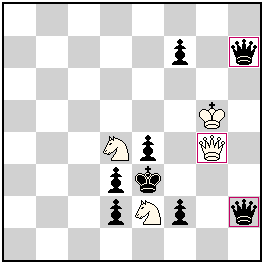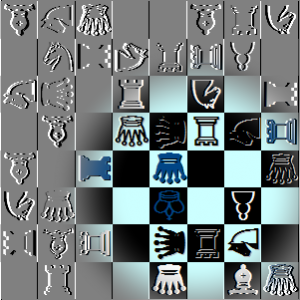|
|
Original Problems (page 48)Original fairy problems published during 2012 will participate in the informal tourney JF-2012. The site is mostly about fairies, but h# and s# are also welcomed for publication! Please send your problems to my e-mail: julia@juliasfairies.com Go to →List of Problems; →Page 47 ; →Page 49 |
A problem No.100 ! I can’t believe it myself, but this is the day when I have to publish it! The last week I was thinking about whom to give this number.. and finally decided to use it myself! 🙂
I’d like to dedicate this problem to all of you, dear authors, commentators, visitors! What I have done is really what we have done all together! Thank you !!
No.100 – hs#3* by Julia Vysotska – Three active Queen-Chameleons! (JV)
Definition:
Chameleon: On completing a move, a Chameleon (from classical standard type) changes into another piece, in the sequence Q-S-B-R-Q… Promotion may be to a chameleon at any stage in the cycle.
You can сlick on “Solutions” to show or hide the solutions!
|
No.100 Julia Vysotska
Latvia
original-17.08.2012
Dedicated to all authors, visitors and commentators of this site!
 hs#3* (4+8)
Сhameleons: Qg4, Qh2, Qh7
Solutions: (click to show/hide)
Creation of black reciprocal batteries CS/CQ after critical moves of black Chameleons.
Interchange of functions between the both black Chameleons.
Thematic tries; chameleon-echo model mates. Meredith. (Author)
|
The diagrams are made on WinChloe and its Echecs font is used for Logo design




Another great idea from Julia!
The version below uses two Locusts to reduce pieces from [4+8] to [5+4]
The eight squares adjacent to the bK are vacant.
whi kg5 se6 la8c2
bla ke3 pf7
whi chameleon qg4
bla chameleon qh7h2
HS#3*
Chameleon h7 g4 h2
Locusts c2a8
1…cQh7-h4=cS 2.Kg5-h5 f7-f6 3.cQg4-f5=cS + cSh4*f5=cB #
1.cQg4-e2=cS cQh2-h5=cS 2.Kg5-h4 f7-f5 3.cSe2-f4=cB + cSh5*f4=cB #
Dear Peter,
Thank you for your interest to my problem!
But there’s something I can’t agree with: I believe that fairy pieces shouldn’t be used as a technical pieces.
This is your diagram:
[img]http://www.ankona.ch/diagrams/99972.png[/img]
HS#3*
Chameleon h7 g4 h2
Locusts c2a8
1…cQh7-h4=cS 2.Kg5-h5 f7-f6 3.cQg4-f5=cS + cSh4*f5=cB #
1.cQg4-e2=cS cQh2-h5=cS 2.Kg5-h4 f7-f5 3.cSe2-f4=cB + cSh5*f4=cB #
Locust is on the board and it doesn’t make a single move here!
Isn’t a Locust too interesting and original piece to just guard a squares? I like this piece, and it was presented on the site many times in a problems, showing it’s specific nature and adding something like a “zest” to the problem. I’d never agree to put this one as you offer – immovable in the corner!
Of course, this is not only about Locust. I prefer to use fairy pieces to highlight (or to make an accent on) something special, which can be done using their specifics or nature. And to leave a technical role to the orthodox pieces, and as less powerful as possible.
Anyway, I appreciate any comment! Thanks!!
Very nice idea indeed from Julia showing the black queens interchanging roles to form batteries. Chameleon echo mates and the different moves of black pawn f7 add to the variety, The different check to the black king is good too.
But I feel that the play is mostly around the white king, while the black king is tied up and ready to be checked. Perhaps the idea (except the part of white checking black) is better shown as a Helpmate I think.
I believe, that in case of helpmate a part of the idea would be lost. Or do you have any scheme for it?
But I agree with you, that the black King is absolutely immobile. Now I’m trying to realize the similar mechanism, but with the both Kings active. Thanks!
You are right. As a helpmate the white queen transformations would be lost. While a mobile black king will be welcome, what I meant was that none of the black moves set up the black king.
Dear Julia,
I suppose it was the sight of the stationary mass of four bPs and two wSs surrounding the bK which upset my aesthetic sense. However if you do not mind such an idea then perhaps you would like the following version. It has the merit that the units surrounding the bK are all Ps, there are no wSs and the only pieces are the three thematic. There are now two solutions and the condition ChameleonChess applies.
[Our opinions differ regarding the use of Locusts in my previous version].
whi kg5 qg4 pg3h3
bla ke3 qh2h7 pd2d3d4e2e4f2f3f7
hs#3 chameleonchess
[img]http://www.ankona.ch/diagrams/99973.png[/img]
1.Qg4-e6=S Qh7*h3=S + 2.Kg5-h4 f7-f5 3.Se6-f4=B + Sh3*f4=B #
1.h3-h4 Qh7*h4=S 2.Kg5-h5 f7-f6 3.Qg4-f5=S + Sh4*f5=B #
I forgot to mention the possibility of replacing the bPf7 with bSa7b7. The solutions being:
1.Qg4-e6=S Qh7*h3=S + 2.Kg5-h4 Sa7-c8=B 3.Se6-f4=B + Sh3*f4=B #
1.h3-h4 Qh7*h4=S 2.Kg5-h5 Sb7-d8=B 3.Qg4-f5=S + Sh4*f5=B #
The bSs reinforce the chameleon theme very nicely.
I know that having two knights for one pawn will cause panic in some circles – but that is what I would choose!
It’s amazing how different the views can be!
I won’t like to argue what is better, I will just comment a little what I prefer myself and why:
1) 7 black pawns around the black King – visually I feel this position is too heavy.
2) White pawn g3 – it gives no try in the second solution as the move 3… CQ2xf4=CS is not possible anymore. So, kind of disbalance in the solutions.
3) White pawn h3 and moves of black cQ – you have just one of them, cQh7, playing in the both solutions. But I like to have interchange of functions!
4) You write about “having two knights for one pawn”. And this is not just a Knight! It is also Chameleon piece! And in one solution each of them do nothing.. absolutely! If even it was just one Chameleon-Knight doing 2 different moves in 2 solutions to guard 1 square, I’d still think about if such usage is justified..
Again, this is my subjective view. And I appreciate your comments a lot!
Something more about Chameleon piece – I believe that soon we’ll get to see some nice examples of usage of this piece at Diyan’s Tourney CHAMELEON – 50 JT 2012
Dear Julia, I saw your problem n.100 just now. I like it! The change of functions between black cQs and the set form of problem is really nice!
About another versions:
-I agree with you that using of technical fairy pieces (as in the version with Locust) is not acceptable;
-The another version by Peter Harris is also not an improvement because there is lost the nice change of functions by the black cQs.
About the replacement of bPf7 with two cSs – this is not good in my opinion because in both solutions one of this Knights is idle. This is not an good option…
So in conclusion – I think that the original published problem is the best choice.
By the way – Seetharaman Kalyan really use this mechanism for H# problem as he noted above and dedicated it to you. Here is the link: http://kobulchess.com/en/problems/chameleon-50-jt-2012-originals/144-chameleon-jt.html
Thank you, Diyan! And yes, I have seen Seetharaman’s problem in your tourney! Waiting for the results!
http://pdb.dieschwalbe.de/search.jsp?expression=PROBID=%27P1306792%27